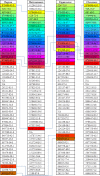An analysis of chemical ingredients network of Chinese herbal formulae for the treatment of coronary heart disease
- PMID: 25658855
- PMCID: PMC4319923
- DOI: 10.1371/journal.pone.0116441
An analysis of chemical ingredients network of Chinese herbal formulae for the treatment of coronary heart disease
Abstract
As a complex system, the complicated interactions between chemical ingredients, as well as the potential rules of interactive associations among chemical ingredients of traditional Chinese herbal formulae are not yet fully understood by modern science. On the other hand, network analysis is emerging as a powerful approach focusing on processing complex interactive data. By employing network approach in selected Chinese herbal formulae for the treatment of coronary heart disease (CHD), this article aims to construct and analyze chemical ingredients network of herbal formulae, and provide candidate herbs, chemical constituents, and ingredient groups for further investigation. As a result, chemical ingredients network composed of 1588 ingredients from 36 herbs used in 8 core formulae for the treatment of CHD was produced based on combination associations in herbal formulae. In this network, 9 communities with relative dense internal connections are significantly associated with 14 kinds of chemical structures with P<0.001. Moreover, chemical structural fingerprints of network communities were detected, while specific centralities of chemical ingredients indicating different levels of importance in the network were also measured. Finally, several distinct herbs, chemical ingredients, and ingredient groups with essential position in the network or high centrality value are recommended for further pharmacology study in the context of new drug development.
Conflict of interest statement
Figures




Similar articles
-
A novel network pharmacology approach to analyse traditional herbal formulae: the Liu-Wei-Di-Huang pill as a case study.Mol Biosyst. 2014 May;10(5):1014-22. doi: 10.1039/c3mb70507b. Mol Biosyst. 2014. PMID: 24492828
-
Herb network construction and co-module analysis for uncovering the combination rule of traditional Chinese herbal formulae.BMC Bioinformatics. 2010 Dec 14;11 Suppl 11(Suppl 11):S6. doi: 10.1186/1471-2105-11-S11-S6. BMC Bioinformatics. 2010. PMID: 21172056 Free PMC article.
-
Effectiveness and pharmacological mechanisms of Chinese herbal medicine for coronary heart disease complicated with heart failure.J Ethnopharmacol. 2024 Mar 25;322:117605. doi: 10.1016/j.jep.2023.117605. Epub 2023 Dec 19. J Ethnopharmacol. 2024. PMID: 38128892 Review.
-
A network pharmacology approach to determine active ingredients and rationality of herb combinations of Modified-Simiaowan for treatment of gout.J Ethnopharmacol. 2015 Jun 20;168:1-16. doi: 10.1016/j.jep.2015.03.035. Epub 2015 Mar 28. J Ethnopharmacol. 2015. PMID: 25824593
-
[Network target: a starting point for traditional Chinese medicine network pharmacology].Zhongguo Zhong Yao Za Zhi. 2011 Aug;36(15):2017-20. Zhongguo Zhong Yao Za Zhi. 2011. PMID: 22066431 Review. Chinese.
Cited by
-
Pure mechanistic analysis of additive neuroprotective effects between baicalin and jasminoidin in ischemic stroke mice.Acta Pharmacol Sin. 2018 Jun;39(6):961-974. doi: 10.1038/aps.2017.145. Epub 2018 Jan 18. Acta Pharmacol Sin. 2018. PMID: 29345255 Free PMC article.
-
Increased Risk of Coronary Heart Disease in Patients with Primary Fibromyalgia and Those with Concomitant Comorbidity-A Taiwanese Population-Based Cohort Study.PLoS One. 2015 Sep 14;10(9):e0137137. doi: 10.1371/journal.pone.0137137. eCollection 2015. PLoS One. 2015. PMID: 26366998 Free PMC article.
-
The Chinese Herbal Formula PAPZ Ameliorates Behavioral Abnormalities in Depressive Mice.Nutrients. 2019 Apr 16;11(4):859. doi: 10.3390/nu11040859. Nutrients. 2019. PMID: 30995790 Free PMC article.
-
Natural formulas and the nature of formulas: Exploring potential therapeutic targets based on traditional Chinese herbal formulas.PLoS One. 2017 Feb 9;12(2):e0171628. doi: 10.1371/journal.pone.0171628. eCollection 2017. PLoS One. 2017. PMID: 28182702 Free PMC article.
-
Therapeutic mechanism of Curcuma aromatica Salisb. rhizome against coronary heart disease based on integrated network pharmacology, pharmacological evaluation and lipidomics.Front Pharmacol. 2022 Aug 9;13:950749. doi: 10.3389/fphar.2022.950749. eCollection 2022. Front Pharmacol. 2022. PMID: 36016561 Free PMC article.
References
-
- Yang M, Jiao LJ, Chen PQ, Wang J, Xu L (2012) Complex systems entropy network and its application in data mining for Chinese medicine tumor clinics. Mod. Tradit. Chin. Med. Mater. Med. 14(2): 1376–1383.
Publication types
MeSH terms
Substances
LinkOut - more resources
Full Text Sources
Other Literature Sources
Research Materials

